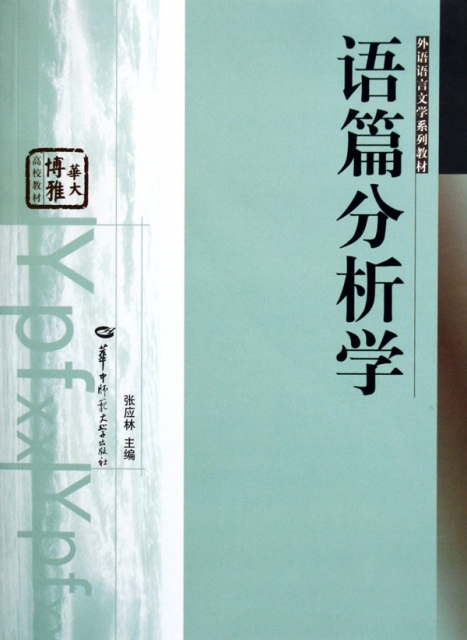| | | | 語篇分析學(外語語言文學繫列教材) | | 該商品所屬分類:外語 -> 外語研究與教學 | | 【市場價】 | 243-352元 | | 【優惠價】 | 152-220元 | | 【介質】 | book | | 【ISBN】 | 7562233640 | | 【折扣說明】 | 一次購物滿999元台幣免運費+贈品
一次購物滿2000元台幣95折+免運費+贈品
一次購物滿3000元台幣92折+免運費+贈品
一次購物滿4000元台幣88折+免運費+贈品
| | 【本期贈品】 | ①優質無紡布環保袋,做工棒!②品牌簽字筆 ③品牌手帕紙巾
|
|
| 版本 | 正版全新電子版PDF檔 | | 您已选择: | 正版全新 | 溫馨提示:如果有多種選項,請先選擇再點擊加入購物車。*. 電子圖書價格是0.69折,例如了得網價格是100元,電子書pdf的價格則是69元。
*. 購買電子書不支持貨到付款,購買時選擇atm或者超商、PayPal付款。付款後1-24小時內通過郵件傳輸給您。
*. 如果收到的電子書不滿意,可以聯絡我們退款。謝謝。 | | | |
| | 內容介紹 | |

-
出版社:華中師大
-
ISBN:7562233640
-
作者:張應林
-
頁數:250
-
出版日期:2006-02-01
-
印刷日期:2013-01-01
-
包裝:平裝
-
開本:16開
-
版次:1
-
印次:1
-
字數:265千字
-
本書綜合介紹國外近十年來*新的語篇分析理論及研究成果,共分八章:第一章,從理論上回顧語篇分析發展的歷程,著重討論對語篇、語篇分析的不同界定、語篇的特征、語篇分析的原則及常用方法;第二章探討語篇的功能及語篇的主要形式;第三章,主要從宏觀上論述與語篇結構相關聯的線性化問題、語篇起首及演示、信息結構等問題,重點實例分析記敘文和議論文的篇章結構;第四章,以韓禮德的“Cohesion in English”為主要依據,綜合近幾年**外學者的有關語篇銜接與連貫的相關理論,全面介紹語篇銜接手段及影響連貫的因素;第五章,從語言、文化和認知的角度探討語境的概念,並探討語境在語篇分析中的作用;第六章,從社會和文化的層面分析語篇,探討語篇與社會、文化之間的關繫;第七章,從心理的層面分析語篇,是語篇的深層次分析,重點討論語篇與認知的關繫及相關認知模式;第八章,簡要介紹:Portter & Wetherell提出的語篇分析“十步法(10 stages)”。
該書內容新穎,語料翔實,可以作為英語專業本科生、研究生語篇分析學課程的教材來使用,也可供對該領域研究有興趣者參考。
-
Chapter 1 Discourse and Discourse Analysis
1.1 What Is Meant by "Discourse" ?
1.1.1 Terminology: Discourse/Text
1.1.2 Discourse and Grammar
1.1.3 Discourse and Sentence
1.1.4 Discourse in Context
1.1.5 Discourse as Verbal Structure
1.1.6 Discourse as Action and Interaction in Society
1.1.7 Seven Criteria for Textuality
1.2 What Is Meant by "Discourse Analysis"?
1.2.1 The Origins of Discourse Analysis
1.2.2 The Scope of Discourse Analysis
1.2.3 Principles of Discourse Analysis
1.2.4 Major Approaches to Discourse Analysis
Chapter 2 Linguistic Forms and Functions
2.1 Language Functions
2.1.1 Halliday's Theory of Metafunctions
2.1.2 Jakobson's Macro-function
2.1.3 Brown and Yule's Conception
2.2 Spoken Discourse
2.3 Conversation
2.3.1 Rules of Turn-taking
2.3.2 Strategies of Turn-taking
2.3.3 Adjacency Pairs
2.3.4 The Cooperative Principle
2.3.5 Violation of the Maxims
2.4 Written Discourse
2.4.1 Types of Written Discourse
2.4.2 The Patterns in Written Discourse
2.5 Distinctions Between Spoken Discourse and Written Discourse
2.5.1 Differences in the Manner of Production and Reception
2.5.2 Differences in Form
2.5.3 Differences in Function
2.5.4 Differences in Linguistic Characteristics
Chapter 3 Diseourse Structure
3.1 The Linearization Problem
3.2 Information Structure
3.3 Thematization and Staging
3.3.1 Thematization
3.3.2 Staging
3.4 Rank Structure
3.4.1 Lesson
3.4.2 Transaction
3.4.3 Exchange
3.4.4 Move
3.4.5 Act
3.5 Narration
3.5.1 The Concept of Narration
3.5.2 The Labov Model
3.5.3 Analyzing a Narrative Discourse
3.6 Argumentation
3.6.1 The Concept of Argumentation
3.6.2 The Basic Reasoning Pattern in Argumentation
3.6.3 The Basic Structure of Argumentation
3.6.4 Analyzing an Argumentative Discourse
Chapter 4 Cohesion and Coherence in Discourse
4.1 Cohesion
4.1.1 Text and Texture
4.1.2 Cohesion and Cohesive Ties
4.1.3 Classification of Cohesive Ties
4.2 Coherence
4.2.1 Topics in Discourse
4.2.2 General Knowledge
4.2.3 Principle of Analogy
4.2.4 Speech Act
4.2.5 Conversational Implicature
Chapter 5 Discourse Context
5.1 Notions of Context
5.1.1 From the Perspective of Linguistics
5.1.2 From the Perspective of Culture
5.1.3 From the Perspective of Cognition
5.2 Functions of Context
5.2.1 Restrictive Function
5.2.2 Explanatory and Filtering Function
5.2.3 Designing Function
Chapter 6 Discourse, Culture and Society
6.1 Discourse and Culture
6.1.1 Definitions of Culture
6.1.2 Culture as Knowledge
6.1.3 Culture as Communication
6.1.4 Culture as Behavior
6.1.5 Culture as a System of Practices
6.1.6 Discourse in Culture and Culture in Discourse
6.1.7 Speech Communities
6.1.8 Discourse Communities
6.2 Discourse and Society
6.2.1 Discourse in Society and Society in Discourse
6.2.2 Discourse and Power
6.2.3 Discourse and Ideology
Chapter 7 Discourse and Cognition
7.1 Discourse Comprehension
7.1.1 World Knowledge
7.1.2 Top-down and Bottom-up Processing
7.1.3 Knowledge Structure: Schemata, Frames and Scripts
7.2 Social Cognitiori
7.2.1 Mentalist Social Cognition
7.2.2 Sociocultural Cognition
7.3 Cognition and Cognitive Models
7.3.1 Cognition
7.3.2 Categorization
7.3.3 Prototypes and Prototype Effects
7.3.4 Idealized Cognitive Models (ICMs)
7.3.5 Cognitive Models of Discourse Comprehension
Chapter 8 How to Analyze Discourse
8.1 Stage One: Research Questions
8.2 Stage Two: Sample Selection
8.3 Stage Three: Collection of Records and Documents
8.4 Stage Four: Interviews
8.5 Stage Five: Transcription
8.6 Stage Six: Coding
8.7 Stage Seven: Analysis
8.8 Stage Eight: Validation
8.9 Stage Nine: The Report
8.10 Stage Ten: Application
Bibliography
| | |
| | | | |
|




